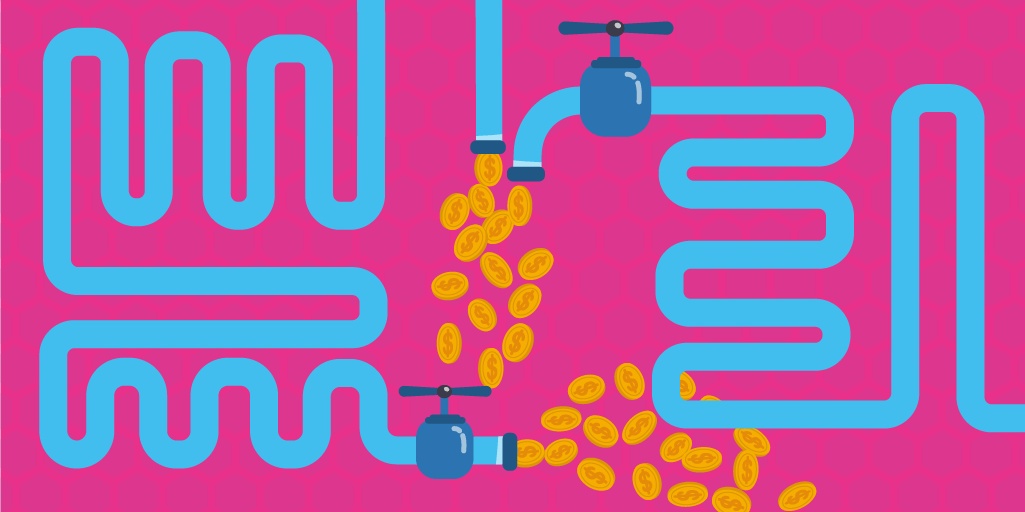Cash flow financing is a type of funding in which money is loaned to small businesses and is then backed by the company’s projected future cash flow. Cash flow financing works by using future cash flows as collateral instead of physical assets.
Cash flow is the amount of money going in and coming out of a business during any specified period of time.
Cash flow funding is different from other types of small business loans that are backed by using a company’s assets as collateral. Cash flow loans for small businesses are a great alternative lending option for those that do not have physical assets to put up as collateral.
This could be because the business is too young to own assets. However, it is important to note that not every small business owns physical assets. A business could generate a significant amount of money from its sales and still be asset-free.
That said, even asset-free businesses need funding. Cash flow funding can be used to help small businesses pay rent, pay employees, cover inventory costs, and help cover pretty much any other business costs. The borrower then repays the loan with cash generated by the business. You know what they say, you gotta spend money to make money.
As is true with any type of loan, it is important to understand what cash flow financing is all about before signing with any lenders. This article will cover the details of cash flow financing for small businesses, so you can make the right choice for your business.
Understanding Cash Flow Financing
The terms of conventional bank loans are usually determined based on a combination of factors including a business’s credit score, assets, net revenue, and others.
While lenders in this case might do a cash flow generation assessment, it is not always a requirement so long as the business is deemed qualified by the lender in other departments.
When it comes to cash flow financing, however, the borrower’s capacity to generate cash flow is one of the most, if not the most important factor. This is because cash flow loans are business loans based on cash flow. If your small business has a positive cash flow, this is a good indicator that you will be able to handle the financial obligations that come with borrowing money.
While asset-based loans use physical assets as collateral, cash-flow loans use a business’s future money as a type of collateral. The amount of cash a business is set to make will then dictate the terms of the cash flow business loan. Businesses with high margins reflected in their balance sheets may find cash flow loans more accessible since these loans emphasize cash flows over traditional balance sheet assets.
With cash flow finance, small businesses receive funds for expansion or general operations costs and are basically borrowing their own future money from themselves to make it happen.
How Does Cash Flow Financing Work?
Cash flow financing can be both term loans or a line of credit, and are best when businesses need money quickly. This is because there is a shorter approval window than regular business loans, sometimes being as quick as 24 hours. After you apply for a cash flow business loan, the lender will generally check your credit score and assess your business’s revenue. While a business credit score is a factor in loan approvals, business performance often carries more weight. Maintaining a good business credit score is important as it helps separate business and personal finances, protecting personal assets and enhancing funding opportunities.
The application process is usually pretty simple and most lenders offer accessible qualification requirements. Because cash flow loans are usually reserved for businesses without assets, cash flow lenders compensate for the added risk in other ways.
For one thing, cash flow based lenders charge higher interest rates than traditional bank loans, ranging between 10%-99% ARP. There are also some other fees to look out for like high origination fees and late repayment fees. Many cash flow lenders also require borrowers to sign personal guarantees.
A personal guarantee is when the business owner takes personal responsibility for repaying the loan from their own money if the business cannot do so for any reason. Depending on the terms of the loan, your business will make payments to the lender either weekly or monthly until the full amount has been repaid.
How to Project a Company’s Future Cash Flow
You might be wondering how to project a company’s future cash flow for the purpose of receiving cash flow funding. Lenders assess future cash flows by examining a company’s cash flow statement and accounts receivable to estimate projected income, which then determines the size and terms of the financing options available. In order to perform a cash flow analysis, you need to look at a few areas of the business. The first of which is the cash flow statement.
The Cash Flow Statement
The cash flow statement is a record that should be filled out at least once a month in order to determine the status of your company’s cash flow and understand the sources and uses of cash within the business. The statement will always start with your business’s total cash balance. The cash flow statement will then include all of the cash inflows and outflows during the allotted period of time. The cash flow statement can be divided into three main sections; operating activities, investing activities, and financing activities.
- Operating activities include all company expenses and income from sales. Operating activities are accounts payable and receivable plus taxes, assets, and liabilities.
- Investing activities include any cash related to buying or selling company-related investments like equipment.
- Financing activities are all debt and equity-related business activities, like receiving and repaying loans.
After adding up all these sections, the cash flow statement will end with the net amount of money for the chosen period. This number will either be more than the month before, which is a positive cash flow, or less which is a negative cash flow.
Projecting Cash Flow
In order to project future cash flows, let’s go back to accounts payable and accounts receivable. Accounts receivable are sales that your business made, but may not have been paid for yet. For example, a customer may have made a large purchase from you and broken it down into six monthly payments.
If they have only made three payments, you know for the next three months to expect additional payments from this customer.
In other words, you can look at your accounts receivable to get an idea of how much money you are expecting to receive in the coming months from sales you have already made.
Accounts payable, on the other hand, will give lenders an idea of how much money you already owe to suppliers and other set monthly expenses.
By adding up accounts payable and receivable you will get the net amount of cash that can be used by lenders to project future cash flows, otherwise known as cash flow from financing. This is how cash flow based lenders can predict whether or not a business is a good candidate for cash flow financing, and how much money to lend them. Understanding these various sources of cash flows is crucial for assessing a company’s financial health and creditworthiness.
Example of When to Use a Cash Flow Loan
A small clothing designer is participating in a series of craft markets in a few weeks. She is seeking $7,000 of funding for new cloth, buttons, zippers, and other materials to finish her new collection.
Because she works from home with a couple of sewing machines and has no physical assets to use for collateral, she is not eligible for a traditional bank loan.
Instead, she applies for cash flow lending to cover the cost of her materials. As she turns the materials into clothes and sells them at the markets, she is able to repay the loan with the cash she made.
To Sum Up
Cash flow financing can be the perfect solution for small businesses that need immediate funding and don’t qualify for other types of small business loans. Cash flow financing is a type of unsecured loan, which does not require physical assets as collateral. However, it is important to be aware of potential hidden fees and high-interest rates. Remember, the faster your business repays the cash flow loan, the better.


















